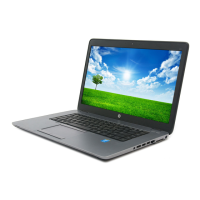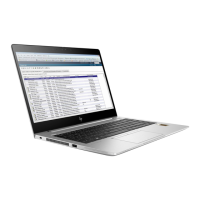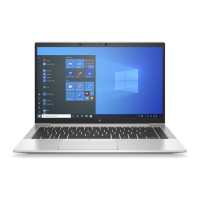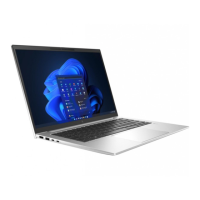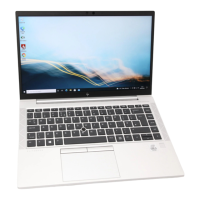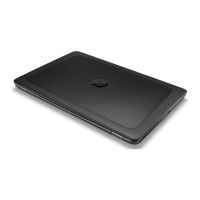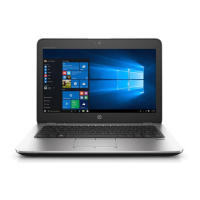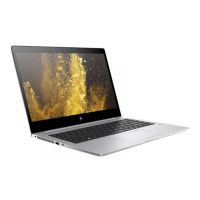Do you have a question about the HP ELITEBOOK 840 G4 and is the answer not in the manual?
Lists the CPU options, including Intel Core i3, i5, and i7 models.
Details screen sizes, resolutions, brightness, and surface treatments available.
Covers memory type, speed, slots, and maximum capacity supported.
Lists 1TB, 500GB HDDs (standard, self-encrypting, hybrid) with specs.
Details SSD capacities, interfaces (PCIe/SATA), and types (NVMe, TLC, MLC).
Lists and describes the function of each external port on the computer.
Details keyboard keys, pointing stick functions, and touchpad gestures.
Explains security lock, fingerprint reader, TPM, and smart card reader functionalities.
Identifies components that can be replaced by the customer.
Detail ports and slots on the right side, including USB-C, DisplayPort, and card reader.
Detail security cable slot, vents, external monitor port, and smart card reader.
Locates WLAN/WWAN antennas, internal microphones, and webcam on the display assembly.
Focuses on the top surface, detailing keyboard and pointing stick.
Explains touchpad functionality, including gestures and buttons.
Details the meaning of power, privacy, microphone mute, wireless, and touchpad indicator lights.
Locates and describes the power button, speakers, volume controls, and fingerprint reader.
Details keys like ESC, Fn, Windows, Function, Num Lock, and embedded numeric keypad.
Using Fn key combinations for system functions and shortcuts.
Locates docking connectors and cooling vents on the underside of the notebook.
Explains service, regulatory, and wireless certification labels found on the device.
Provides an overview of major computer parts and their associated part numbers.
Details parts for the display assembly, such as bezels, touch screens, and privacy panels.
Provides part numbers for keyboards, including backlit and privacy options.
Details part numbers for the computer's top casing.
Identifies the spare part number for the power button board assembly.
Provides the part number for the integrated smart card reader.
Identifies the part number for the Near Field Communication module.
Provides the part number for the fingerprint sensor assembly.
Details part numbers for system boards with different Intel processors.
Provides the part number for the thermal management assembly.
Details part numbers for 4GB, 8GB, and 16GB DDR4 memory modules.
Provides part numbers for SSDs with capacities from 128GB to 512GB.
Details part numbers for 1TB and 500GB hard drives, including hybrid and security options.
Identifies the part number for the computer's bottom casing.
Details parts like bezels, webcam, microphone, raw panel, and hinges.
Details parts like fingerprint reader blanks, RJ-45 door, and rubber feet.
Details parts like display/webcam cables and card reader cables.
Details AC adapters, power cords for different regions, and display cables.
Specifies the Phillips P0 screwdriver as the primary tool required.
Offers advice on handling subassemblies, screws, and plastic parts during service.
Details how to properly handle and route cables to avoid damage.
Offers guidance on safely removing, handling, and protecting storage drives.
Details ESD risks and precautions, including a table on static voltage levels.
Covers grounding for packaging, transport, workstations, and component handling.
Step-by-step instructions for accessing internal components by removing the bottom cover.
Instructions for safely disconnecting and removing the internal battery.
Step-by-step guide for removing and installing the 2.5-inch hard disk drive.
Instructions for removing and installing the M.2 Solid-State Drive.
Guide for removing and installing DDR4 memory modules in the available slots.
Advises on updating the BIOS for compatibility and stability with new RAM.
Instructions for servicing the wireless communication module.
Instructions for servicing the wireless wide area network module.
Guide for removing and replacing the Real-Time Clock battery.
Step-by-step instructions for removing and reinstalling the keyboard assembly.
Instructions for authorized personnel to remove the computer's internal base plate.
Instructions for authorized personnel to remove and replace the heat sink and fan.
Instructions for authorized personnel to remove and replace the fingerprint sensor.
Instructions for authorized personnel to remove and replace the touchpad assembly.
Instructions for authorized personnel to remove and replace the NFC module.
Instructions for authorized personnel to remove and replace the smart card reader.
Instructions for authorized personnel to remove and replace the USB/audio interface board.
Instructions for authorized personnel to remove and replace the main system board.
Instructions for authorized personnel to remove and replace the power button board.
Instructions for authorized personnel to remove and replace the top casing.
Explains how to enter, navigate, and use the Computer Setup (BIOS) utility.
Steps to restore BIOS to original factory default settings.
Information on checking for and downloading BIOS updates from HP.
Steps to download BIOS updates from the HP support website.
Instructions for using the F9 prompt to select a boot device for the current startup.
Instructions for accessing and modifying TPM settings for enhanced security.
Explains HP Sure Start's role in monitoring and restoring BIOS integrity.
Steps to download and create a bootable USB for HP PC Hardware Diagnostics.
Overview of creating recovery media using HP Recovery Manager or Windows tools.
Detailed instructions for creating recovery media on discs or USB drives.
Explains how to use Windows tools for system restore points and data backups.
Outlines methods like refreshing, resetting, and reinstalling applications.
Instructions for performing system recovery using HP Recovery Manager software.
Covers important notes on recovery, including software sources and final attempt procedures.
Guide to using the built-in recovery partition for system restoration.
Steps to restore the system using created or obtained recovery media.
Instructions for modifying the boot sequence via BIOS or startup menu.
Guide on how to delete the recovery partition to increase storage capacity.
Details physical dimensions, weight, and input power specifications.
Provides screen resolution, brightness, viewing angle, and panel interface details.
Lists specs for 128GB, 256GB, and 512GB SSDs, including form factor and transfer rates.
Provides specs for 1TB and 500GB HDDs, including dimensions, speed, and security.
Specifies length, current capacity, voltage rating, and connector type for power cords.
Details accredited agencies and applicable note numbers for power cords in various countries.
Instructions for BIOS operations, including restoring defaults and security settings.
Steps for restoring BIOS and security settings on legacy BIOS systems.
Details system BIOS, Intel ME, flash memory, and EEPROM usage and protection.
Answers frequently asked questions about BIOS restoration, UEFI vs. legacy BIOS, and memory types.
Lists the CPU options, including Intel Core i3, i5, and i7 models.
Details screen sizes, resolutions, brightness, and surface treatments available.
Covers memory type, speed, slots, and maximum capacity supported.
Lists 1TB, 500GB HDDs (standard, self-encrypting, hybrid) with specs.
Details SSD capacities, interfaces (PCIe/SATA), and types (NVMe, TLC, MLC).
Lists and describes the function of each external port on the computer.
Details keyboard keys, pointing stick functions, and touchpad gestures.
Explains security lock, fingerprint reader, TPM, and smart card reader functionalities.
Identifies components that can be replaced by the customer.
Detail ports and slots on the right side, including USB-C, DisplayPort, and card reader.
Detail security cable slot, vents, external monitor port, and smart card reader.
Locates WLAN/WWAN antennas, internal microphones, and webcam on the display assembly.
Focuses on the top surface, detailing keyboard and pointing stick.
Explains touchpad functionality, including gestures and buttons.
Details the meaning of power, privacy, microphone mute, wireless, and touchpad indicator lights.
Locates and describes the power button, speakers, volume controls, and fingerprint reader.
Details keys like ESC, Fn, Windows, Function, Num Lock, and embedded numeric keypad.
Using Fn key combinations for system functions and shortcuts.
Locates docking connectors and cooling vents on the underside of the notebook.
Explains service, regulatory, and wireless certification labels found on the device.
Provides an overview of major computer parts and their associated part numbers.
Details parts for the display assembly, such as bezels, touch screens, and privacy panels.
Provides part numbers for keyboards, including backlit and privacy options.
Details part numbers for the computer's top casing.
Identifies the spare part number for the power button board assembly.
Provides the part number for the integrated smart card reader.
Identifies the part number for the Near Field Communication module.
Provides the part number for the fingerprint sensor assembly.
Details part numbers for system boards with different Intel processors.
Provides the part number for the thermal management assembly.
Details part numbers for 4GB, 8GB, and 16GB DDR4 memory modules.
Provides part numbers for SSDs with capacities from 128GB to 512GB.
Details part numbers for 1TB and 500GB hard drives, including hybrid and security options.
Identifies the part number for the computer's bottom casing.
Details parts like bezels, webcam, microphone, raw panel, and hinges.
Details parts like fingerprint reader blanks, RJ-45 door, and rubber feet.
Details parts like display/webcam cables and card reader cables.
Details AC adapters, power cords for different regions, and display cables.
Specifies the Phillips P0 screwdriver as the primary tool required.
Offers advice on handling subassemblies, screws, and plastic parts during service.
Details how to properly handle and route cables to avoid damage.
Offers guidance on safely removing, handling, and protecting storage drives.
Details ESD risks and precautions, including a table on static voltage levels.
Covers grounding for packaging, transport, workstations, and component handling.
Step-by-step instructions for accessing internal components by removing the bottom cover.
Instructions for safely disconnecting and removing the internal battery.
Step-by-step guide for removing and installing the 2.5-inch hard disk drive.
Instructions for removing and installing the M.2 Solid-State Drive.
Guide for removing and installing DDR4 memory modules in the available slots.
Advises on updating the BIOS for compatibility and stability with new RAM.
Instructions for servicing the wireless communication module.
Instructions for servicing the wireless wide area network module.
Guide for removing and replacing the Real-Time Clock battery.
Step-by-step instructions for removing and reinstalling the keyboard assembly.
Instructions for authorized personnel to remove the computer's internal base plate.
Instructions for authorized personnel to remove and replace the heat sink and fan.
Instructions for authorized personnel to remove and replace the fingerprint sensor.
Instructions for authorized personnel to remove and replace the touchpad assembly.
Instructions for authorized personnel to remove and replace the NFC module.
Instructions for authorized personnel to remove and replace the smart card reader.
Instructions for authorized personnel to remove and replace the USB/audio interface board.
Instructions for authorized personnel to remove and replace the main system board.
Instructions for authorized personnel to remove and replace the power button board.
Instructions for authorized personnel to remove and replace the top casing.
Explains how to enter, navigate, and use the Computer Setup (BIOS) utility.
Steps to restore BIOS to original factory default settings.
Information on checking for and downloading BIOS updates from HP.
Steps to download BIOS updates from the HP support website.
Instructions for using the F9 prompt to select a boot device for the current startup.
Instructions for accessing and modifying TPM settings for enhanced security.
Explains HP Sure Start's role in monitoring and restoring BIOS integrity.
Steps to download and create a bootable USB for HP PC Hardware Diagnostics.
Overview of creating recovery media using HP Recovery Manager or Windows tools.
Detailed instructions for creating recovery media on discs or USB drives.
Explains how to use Windows tools for system restore points and data backups.
Outlines methods like refreshing, resetting, and reinstalling applications.
Instructions for performing system recovery using HP Recovery Manager software.
Covers important notes on recovery, including software sources and final attempt procedures.
Guide to using the built-in recovery partition for system restoration.
Steps to restore the system using created or obtained recovery media.
Instructions for modifying the boot sequence via BIOS or startup menu.
Guide on how to delete the recovery partition to increase storage capacity.
Details physical dimensions, weight, and input power specifications.
Provides screen resolution, brightness, viewing angle, and panel interface details.
Lists specs for 128GB, 256GB, and 512GB SSDs, including form factor and transfer rates.
Provides specs for 1TB and 500GB HDDs, including dimensions, speed, and security.
Specifies length, current capacity, voltage rating, and connector type for power cords.
Details accredited agencies and applicable note numbers for power cords in various countries.
Instructions for BIOS operations, including restoring defaults and security settings.
Steps for restoring BIOS and security settings on legacy BIOS systems.
Details system BIOS, Intel ME, flash memory, and EEPROM usage and protection.
Answers frequently asked questions about BIOS restoration, UEFI vs. legacy BIOS, and memory types.
| Color | gray |
|---|---|
| Date of Release | 2021 |
| Optical Drive | none |
| OS | windows 10 pro |
| Touch Screen | no |
| Screen Size | 14 inches |
| Screen Resolution | 1366 x 768 (hd) |
| Processor Brand | intel |
| Processor Model | intel 7th generation core i5 |
| Processor Model Number | 7300u |
| CPU Base Clock Frequency | 2.6 gigahertz |
| CPU Cores | 2-core (dual-core) |
| Storage Type | ssd |
| Storage Capacity | 512 gigabytes |
| SSD Capacity | 512 gigabytes |
| Type of Memory | ddr4 |
| System Memory | 16 gigabytes |
| GPU | intel uhd graphics 620 |
| GPU Brand | intel |
| Graphics Type | integrated |
| Front Facing Camera | yes |
| Backlit Keyboard | yes |
| Wireless Connectivity | wi-fi |
| Display Connectors | 1 x displayport |
| USB Ports | 2 x usb-a 3.1, 1 x usb-c 3.1 |
| Number of USB Ports | 3 |
| Battery Type | lithium-ion |
| Depth | 9.3 inches |
|---|---|
| Height | 0.7 inches |
| Width | 13.3 inches |
| Net Weight | 3.26 pounds |
